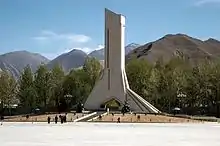
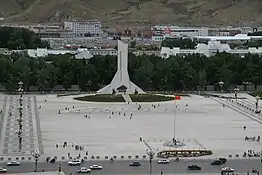
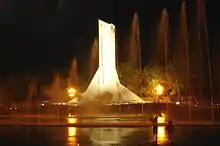
The Monument to the Peaceful Liberation of Tibet (Chinese: 西藏和平解放纪念碑) stands in the southern part of the Potala square in Lhasa, Tibet Autonomous Region just outside the protective zone and buffer zone of the World Heritage Site.[1] It celebrates what the People's Republic of China calls the Peaceful Liberation of Tibet by the People's Liberation Army,[2] or what the exiled Tibetan government calls the invasion and annexation of Tibet. The foundation stone was laid on July 18, 2001 by Hu Jintao, China's vice-president at the time.[3] The monument was unveiled on May 22, 2002.[4]
The US $1.7 million, 37-meter-high spire-like concrete structure was designed by Professor Qikang of the Southeast University in Nanjing, China.[5] The monument abstractly portrays Mount Everest.[6] The monument bears its own name engraved in the calligraphy of former general secretary and president Jiang Zemin, while an inscription refers to the expelling of "imperialist" forces from Tibet in 1951 (a reference to long-running Anglo-Russian Great-Game designs on the region) and reports on the socio-economic development achieved since then.[7][8]
When apprised of the plans to build the memorial, the Tibetan government in exile claimed that "the monument would serve as a daily reminder of the humiliation of the Tibetan people." Kate Saunders, then spokeswoman for International Campaign for Tibet,[9] said the construction in this sensitive spot is a political message to Tibetans about Chinese rule over the region.[10]
Gallery
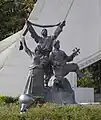 Left group of statues outside the memorial
Left group of statues outside the memorial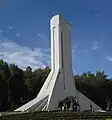 The spire-like Mount Quomolongma (Everest)
The spire-like Mount Quomolongma (Everest) Right group of statues outside the memorial
Right group of statues outside the memorial
See also
References
- ↑ (in French) Décision-25COM X.B-Ensemble historique du Palais du Potala, Lhasa (Extension pour inclure la zone de Norbulingka (Chine), 2001 :
Concernant la tour de 35 m de haut commémorant « la libération paisible du Tibet », la mission UNESCO a vérifié que cette nouvelle construction était bien située à l'extérieur des zones de protection du site du patrimoine mondial, du côté sud de la Nouvelle Place du Potala.
Regarding the 35 m high tower commemorating "the peaceful liberation of Tibet", the UNESCO mission verified that this new construction was well located outside the protection zones of the World Heritage site, on the south side of the New Potala Square. - ↑ To Zhu Weiqun, Executive Vice Minister of the United Front Work Department of the Central Committee of the Chinese Communist Party, "The peaceful liberation of Tibet completed the liberation and unification of China's mainland and was a victory over imperialist forces and a few upper-class Tibetans who wished to split Tibet from China" » (Peaceful Liberation Ushers in a New Era Archived 2011-09-27 at the Wayback Machine, BEIJING REVIEW.com.cn, July 25, 2011.)
- ↑ Photo: "Chinese Vice-President Hu Jintao and other leading members of the central delegation bury the foundation stone of the 'Monument to the Peaceful Liberation of Tibet' at the foundation laying ceremony held on the Potala Palace Square in Lhasa, capital of the Tibet Autonomous Region, Wednesday July 18, 2001."
- ↑ Monument Erected to Commemorate Tibet Liberation, op. cit.: "A grand ceremony was held Wednesday in the Potala Palace in Lhasa to unveil the Tibet Peaceful Liberation Monument."
- ↑ "Fifity Years in Tibet". 2011-09-28. Archived from the original on 2012-04-01. Retrieved 2017-07-25.
{{cite web}}: CS1 maint: bot: original URL status unknown (link) - ↑ "Monument to Tibet Peaceful Liberation Unveiled - History - China TIBET Tourism Bureau". 2012-03-01. Archived from the original on 2012-03-01. Retrieved 2017-07-25.
- ↑ "Monument to Tibet Peaceful Liberation Unveiled - History - China TIBET Tourism Bureau". 2012-03-01. Archived from the original on 2012-03-01. Retrieved 2017-07-25.
- ↑ Monument Erected to Commemorate Tibet Liberation, peopledaily.com.cn, Thursday, May 23, 2002: "The inscription on the monument says the People's Liberation Army expelled the imperialist forces from Tibet in 1951, which led Tibet to advancement, prosperity, democracy and opened a new era." Archived here.
- ↑ "Our Team - International Campaign for Tibet". web.savetibet.org. 2019-11-15. Archived from the original on 2019-11-15. Retrieved 2019-11-22.
- ↑ Anger over Tibet monument, BBC News, February 5th, 2002. Archived here QUOTATION- "But a spokeswoman for the London-based Tibet Information Network, Kate Saunders, says the statue's construction in such a sensitive spot shows it is designed to send a political message to Tibetans about Chinese rule over the region. When the plans to build the sculpture were first revealed, the Tibetan government-in-exile said the monument would serve as a daily reminder of the humiliation of the Tibetan people. Tibetan groups in exile have said that thousands of people were killed when Chinese troops entered Tibet, and many others suffered human rights abuses during subsequent Chinese rule."